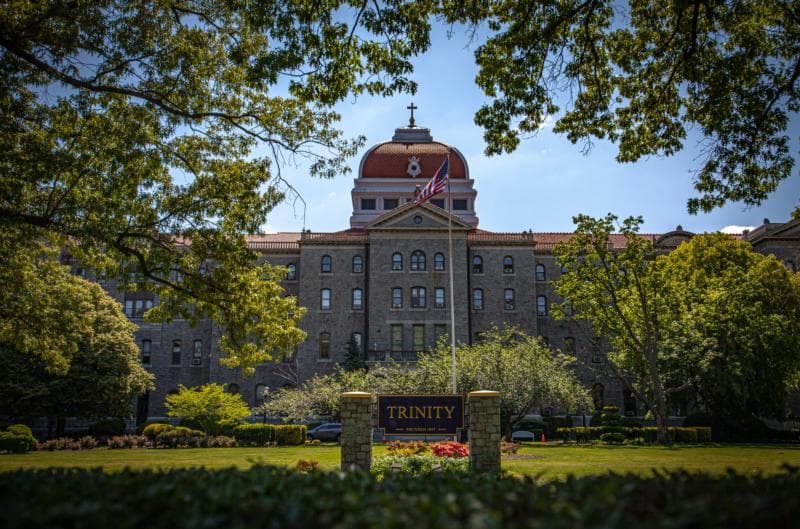BURLINGTON, Vermont — For Catholic colleges across America, the sun has finally set on the 2019-2020 academic year. Students have received their final grades or graduated via livestream, and the stillness of campus seems more fitting than it did the past few months.
But inside the virtual meetings of university leaders, the most trying times of the COVID-19 pandemic are still ahead.
“The goal is twofold,” said Father Dennis Holtschneider, president of the Association of Catholic Colleges and Universities. “How do you operate in a way that keeps people healthy, and how do we actually make this financially work in the coming year?”
For small Catholic schools already operating on razor-thin margins, the questions are daunting, and some fear the schools’ ability to respond could result in the closure or merging of beloved institutions that offer thousands of students — many from low-income backgrounds — a faith-based education.
Holy Family College in Wisconsin was the first school to surrender under the pandemic’s weight, after it announced a plan this month to close by the end of the summer.
RELATED: Catholic college in Wisconsin closing, in part citing COVID-19
The move could be followed by Notre Dame de Namur University in California, which has opted not to enroll new students for the fall semester, and established partnerships with other schools for students to continue their education after the spring of 2021.
“Closing could be in our future, but we are not closing now,” the school said in a statement on its website. “We intend to stay open at least long enough to serve our students who are close to graduating. We hope to find a way to remain open in the future, but we cannot make that guarantee.”
“Not a complicated answer”
The decision for schools to close is a heartbreaking one, but it’s grounded in reality, Holtschneider said. Whether a college should discontinue or not is as simple as the bottom line.
“It’s not a complicated answer,” the Vincentian priest told Crux. “It’s ‘do you have the income to pay your bills?’”
The effects of COVID-19 have hurt schools’ incomes in multiple ways. First, most schools refunded about half of their room and board fees for on-campus students this semester, in proportion to the time spent living in dorms. While officials say that decision was an honorable one, it had a devastating impact on schools.

Many colleges have also been forced to cancel events and classes slated to take place on campus over the summer, another hit to their cash supply.
The biggest wound for colleges, though, could be the fall semester.
To start, no school can authoritatively say what type of instruction will take place in the fall, unless they commit to holding classes online. But the decision to move online comes with trepidation about enrollment numbers.
“There are some institutions that are directly worried about that,” Holtschneider said. “They’re worried — if they go online — students will either say, ‘I’m just going to take the year off, I’m going to take a gap year,’ or, ‘I’m just going to go online and take courses cheaper somewhere else.’”
Joe Marbach, president of Georgian Court University in New Jersey, said his school has seen a decline in enrollment compared to previous years. Georgian Court already moved its deadline for admitted students to secure their spot from May 1 to June 1, and could extend that date even further as the summer approaches.
However, some say concerns of decreased enrollment are overblown. A survey by the American Council on Education and the American Association of Collegiate Registrars and Admissions Officers found that 83 percent of current students already plan to enroll for the fall. Of those intending to enroll, 92 percent said they would stay at their current institution.

Still, even with 8 of 10 students staying, colleges could expect to lose significant tuition revenue.
At St. Anselm’s College in New Hampshire, administrators kept the May 1 deposit deadline for newly admitted students and aren’t observing a serious decline in enrollment.
“We feel comfortable with where the class is,” said Paul Provonost, the chief communications and marketing officer. “Of course, there are still so many unknowns with the whole world that it’s hard to predict what will be happening in the fall.”
The school hasn’t heard any widespread response from current students who are unsure about returning in the fall, he added.
Provonost credits the lack of such a sentiment to the smooth transition to online learning in March.
“I think it has to do with the preparation we took in the spring, and how transparent we have been,” he said.
Marbach believes the same about Georgian Court, saying that his office received only one complaint related to remote instruction from the school’s 1,400 students.
Seeking ways to reopen
However, even if schools can welcome students back on campus in the fall, the measures needed to keep students and employees safe will be costly.
Dr. Anthony Fauci, director of the National Institute of Allergy and Infectious Diseases, told lawmakers last week that university officials shouldn’t count on a vaccine to mitigate the disease’s spread on their campuses.
“The idea of having treatments available, or a vaccine, to facilitate the reentry of students into the fall term would be something of a bit of a bridge too far,” Fauci said. “Even at the top speed we’re going, we don’t see a vaccine playing in the ability of individuals to get back to school this term.”
As a result, schools will have to finance other means to prevent outbreaks in their community beyond the bare minimum of mask-wearing and social distancing. Highly accurate methods of contact tracing and places for infected community members to isolate will be necessary and expensive, as well as countless other changes to the way students dine, sleep, and socialize.
“We understand that this is — not to use the cliché — but it will not be normal in the fall, it will be a new normal,” Provonost said.
Arvid Johnson, president of the University of St. Francis in Joliet, Illinois, said that restrictions on the size of gatherings could be the hardest measure to implement.
“The idea of face masks and social distancing we can deal with, but right now, if gatherings are limited to no more than 10 [people] at a time, that becomes a challenge,” he said. “Even 50 or less becomes a challenge if you think about things like cafeterias, athletic events, and other things that are a part of campus life.”

Another financial concern connected to on-campus instruction is liability. Even with precautions in place, no school can guarantee the virus will not reach their campus, and if it does, lawsuits could follow.
“They may get it from outside school and bring it in,” Marbach said. “Would the school then be liable for whatever medical costs, or — God forbid — if something more serious happens to a student?”
Marbach said Georgian Court is working with the Independent College Fund of New Jersey to express their concerns about liability to state legislators, who could adjust the extent to which schools are legally responsible for student safety.
“If we’ve done everything that we’ve been directed to do, either from the state or the Center for Disease Control, to minimize contact,” Marbach said, “we feel that a level of protection needs to be offered so that we can avoid lawsuits.”
Saving graces
To relieve these financial burdens, schools are implementing a variety of methods to keep cash on hand, including major austerity measures.
Many schools with long-term capital projects, such as the construction and renovation of buildings, have put those on hold. In Texas, St. Edward’s University cut six of its 16 athletic programs.
While those reductions may be necessary, Holtschneider points out that the largest expenditure for any university is paying employees. As a response, schools across the board have announced pay cuts, with some choosing to lay off or furlough employees.

“They’ve really downsized for the spring and summer, hoping they can bring employees back for the fall,” Holtschneider said.
A spokesperson for Georgian Court said the university would be furloughing employees on a rolling basis, and that senior leaders would receive salary reductions.
Still, some schools have committed to paying employees through the immediate downturn, citing their Catholic character. At St. Anselm’s, employees have been guaranteed pay through June 30, the end of the fiscal year.
“We felt it was important to keep paying all of our employees. We felt that was the Anselmian thing to do,” Provonost said.
St. Francis has also been paying employees, Johnson said, and will continue to do so through the end of the month, with the exception of a small number of employees who have been furloughed.
In addition to cutting costs, universities are also receiving money from the federal government and donors, though most of it is earmarked for students.
The CARES Act, signed by President Trump in March, allocated almost $14 billion to colleges and universities. As part of its provisions, institutions were required to give half of those funds directly to students, and could use the other half to pay for pandemic-related expenses, such as purchasing additional protective equipment and cleaning supplies.
While college officials say the funding gave a much-needed boost to their students, many are still looking for ways to weather the short-term losses caused by the pandemic.
The additional funding could come from a new stimulus package backed by House Democrats. The proposed legislation would give colleges more money, and allow them to apply for federal loans currently restricted to small businesses.
“This bill gets a little bit closer to helping the schools get through these tough months,” Holtschneider said.
However, Senate Republicans oppose the bill, calling it “dead on arrival” and a “liberal wish list.”
Both Provonost and Johnson said their schools would consider applying for a federal loan, but couldn’t say precisely what the future holds.
“It’s a great subject, and honestly, it’s not something we’ve looked at,” Provonost said.
While most schools have endowments to supplement or replace federal dollars, these ‘rainy day funds’ are not as substantial at small schools, and less accessible than they may seem.
“If [schools] have an endowment, often the donor of that money gave a restriction to it,” Holtschneider said. “It has to be used for this kind of scholarship program, it has to be used to support that kind of scientific research.”
Still, amidst the greatest crisis many schools have ever faced, institutions aren’t ruling out any source of legitimate cash.
“We’re not taking anything off the table,” Provonost said. “We have a lot of levers to pull, that is one of them.”
The road ahead
As the country continues to learn more about the coronavirus and what can be expected in the upcoming months, college officials remain divided on announcing their fall plans.
St. Francis announced that it intends to have “face-to-face” instruction in the fall, but will ultimately follow state and federal guidelines, and is ready to move online if in-person classes aren’t safe.
St. Anselm’s and Georgian Court have yet to make a decision about what type of learning they will offer, but say they are studying the matter and hope to notify students and parents within the coming weeks.
In the meantime, administrations are working to finalize a budget, even as the future remains unknown.
“The financial picture will continue to be somewhat murky. We have to get comfortable with that. I think all colleges have to get comfortable with that,” Provonost said.
When asked about how many colleges could close due to the pandemic, Holtschneider declined to estimate, but did allude to the enormity of the problem confronting Catholic higher education.
“At this point, nobody’s looking five years out. People are at most looking at all of next year, most of them are trying to get through the fall,” he said. “That’s where all their attention is right now.”














